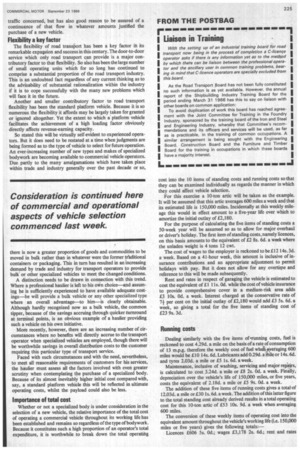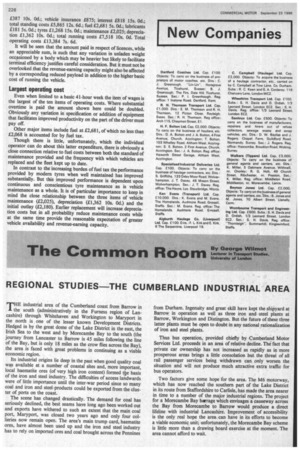VEHICLE SELECTION
Page 250

Page 251

Page 252

If you've noticed an error in this article please click here to report it so we can fix it.
THE combination of the large number of variables of both chassis and body from which the prospective purchaser of a commercial vehicle could select one for his particular use can .inderstandably give rise to confusion if he does not have a clear
..d sound yardstick in mind. Any error in selectiOn would be unfortunate on several counts. The very extensiveness of the range of vehicles provided by a virile British manufacturing industry makes it unlikely that there will be many operational circumstances for which at least one vehicle within that range would not be well suited.
That being so, any other choice would result in the vehicle chosen being less efficient in operation than another would otherwise have been assuming that the choice was not so basically bad that the vehicle was unable to undertake satisfactorily the work for which it was originally chosen. On the score of efficiency even a marginal loss because of an initial error in commercial vehicle selection can ultimately accumulate into a substantial amount.
As explained last week, at the time of the selection of a new vehicle the operator concerned will understandably pay considerable regard to the amount of the initial outlay and because of the credit squeeze this will apply with even more emphasis at the present time. But despite current difficulties in obtaining the necessary finance facilities, the significance of the ratio between the initial outlay and the ultimate cost of operation of the vehicle remains the same. Thus, as exampled last week a two-tonner fitted with a box van would cost around £1,140. But, assuming an average weekly mileage of 400 and an ultimate vehicle mileage life of 100,000, the total cost of operating the vehicle throughout that life would be £7,287. So of a total of £8,427, the relatively small proportion of 15.64 per cent of this expenditure is incurred on the initial outlay in purchasing the vehicle.
It follows therefore that any variation in specification of either chassis or body or both which can appreciably reduce that total cost of operation (or alternatively add to the vehicle's revenueearning capacity) must be a worthwhile proposition. Moreover, because of this ratio of around 15 per cent initial cost and 85 per cent operating cost, relatively small additions to a standard vehicle, and therefore to the initial cost, should result in worthwhile savings by an even greater reduction in operating costs.
But to be in a position to make accurate estimates in just such circumstances does presuppose that the operator concerned has not only considerable knowledge as to the current flow of the traffic concerned, but has also good reason to be assured of a continuance of that flow in whatever amounts justified the purchase of a new vehicle.
Flexibility a key factor
The flexibility of road transport has been a key factor in its remarkable expansion and success in this century. The door-to-door service which only road transport can provide is a major contributory factor to that flexibility. So also has been the large number of small operating units which for so long has continued to comprise a substantial proportion of the road transport industry. This is an undoubted fact regardless of any current thinking as to the advisability of substantial rationalization within the industry if it is to cope successfully with the many new problems which will face it in the future.
Another and smaller contributory factor to road transport flexibility has been the standard platform vehicle. Because it is so numerous the flexibility it affords may be largely taken for granted or ignored altogether. Yet the extent to which a platform vehicle facilitates the achievement of a high loading factor obviously directly affects revenue-earning capacity.
So stated this will be virtually self-evident to experienced operators. But it does need to be restated at a time when judgments are being formed as to the type of vehicle to select for future operation. An ever-increasing number of new types and makes of specialized bodywork are becoming available to commercial vehicle operators. Due partly to the many amalgamations which have taken place within trade and industry generally over the past decade or so, there is now a greater proportion of goods and commodities to be moved in bulk rather than in whatever were the former traditional containers or packaging. This in turn has resulted in an increasing demand by trade and industry for transport operators to provide bulk or other specialized vehicles to meet the changed conditions.
A distinction needs to be drawn in connection with this trend. Where a professional haulier is left to his own choice—and assuming he is sufficiently experienced to have available adequate costings—he will provide a bulk vehicle or any other specialized type where an overall advantage—to him—is clearly obtainable. Although hardly recognized now as a bulk vehicle, the common tipper, because of the savings accruing through quicker turnround at terminal points, is an obvious example of a haulier providing such a vehicle on his own initiative.
More recently, however, there are an increasing number of circumstances where no benefits will directly accrue to the transport operator when specialized vehicles are employed, though there will be worthwhile savings in overall distribution costs to the customer requiring this particular type of transport service.
Faced with such circumstances and with the need, nevertheless, to meet all reasonable requirements of customers for his services, the haulier must assess all the factors involved with even greater scrutiny when contemplating the purchase of a specialized body. Because of its almost inevitably higher initial cost compared with, say, a standard platform vehicle this will be reflected in ultimate operating costs, whilst the payload could also be less.
Importance of total cost
Whether or not a specialized body is under consideration in the selection of a new vehicle, the relative importance of the total cost of operating a commercial vehicle throughout its working life has been established and remains so regardless of the type of bodywork. Because it constitutes such a high proportion of an operator's total expenditure, it is worthwhile to break down the total operating cost into the 10 items of standing costs and running costs so that they can be examined individually as regards the manner in which they could affect vehicle selection.
For this exercise a 10-ton artic will be taken as the example. It will be assumed that this artic averages 600 miles a week and that its estimated life is 150,000 miles. Incidentally at this weekly mileage this would in effect amount to a five-year life over which to amortize the initial outlay of £2,180.
For the purpose of calculating the five items of standing costs a 50-week year will be assumed so as to allow for major overhaul or driver's holiday. The first item of standing costs, namely licences, on this basis amounts to the equivalent of £2 8s. 6d. a week where the unladen weight is 4 tons 12 cwt.
The cost of wages to the employer is reckoned to be £1214s. 3d. a week. Based on a 41-hour week, this amount is inclusive of insurance contributions and an appropriate adjustment to permit holidays with pay. But it does not allow for any overtime and reference to this will be made subsequently.
Rent and rates in respect of garaging the vehicle is estimated to cost the equivalent of £1 lls. Od. while the cost of vehicle insurance to provide comprehensive cover in a medium-risk area adds £3 10s. Od. a week. Interest charged at the conservative rate of 7-,1per cent on the initial outlay of £2,180 would add £3 5s. 6d. a week, so giving a total for the five items of standing cost of £23 9s. 3d.
Running costs
Dealing similarly with the five items of .running costs, fuel is reckoned to cost 4.29d. a mile on the basis of a rate of consumption of 13 m.p.g. therefore the weekly cost of fuel what ayeraging 600 miles would be £10 14s. 6d. Lubricants add 0.29d. a Mile or 14s. 6d. and tyres 2.03d. a mile or £5 is. 6d. a week.
Maintenance, inclusive of washing, servicing and major repairs, is calculated to cost 3.24d. a mile or £8 2s. Od. a week. Finally, depreciation over the vehicle's life of 150,000 miles, or five years, costs the equivalent of 2.18d. a mile or £5 9s. Od. a week.
The addition of these five items of running costs gives a total.of 12.03d. a mile or £30 Is. 6d. a week. The addition of this latter figure to the total standing cost already derived results in a total operating cost for this 10-ton artic of £53 10s. 9d. a week when averaging 600 miles.
The conversion of these weekly items of operating cost into the equivalent amount throughout the vehicle's working life (i.e. 150,000 miles or five years) gives the following totals:—
Licences £606 5s. Od.; wages £3,178 2s. 6d.; rent and rates £387 10s. Od.; vehicle insurance £875; interest £818 15s. Od.; total standing costs £5,865 12s. 6d.; fuel £2,681 5s. Od.; lubricants £181 5s. Od.; tyres £1,268 15s. Od.; maintenance £2,025; depreciation £1,362 10s. Od.; total running costs £7,518 10s. Od. Total operating costs £13,384 7s. 6d.
It will be seen that the amount paid in respect of licences, while an appreciable sum, is such that any variation in unladen weight occasioned by a body which may be heavier but likely to facilitate terminal efficiency justifies careful consideration. But it must not be overlooked that the revenue-earning capacity might also be affected by a corresponding reduced payload in addition to the higher basic cost of running the vehicle.
Largest operating cost Even when limited to a basic 41-hour week the item of wages is the largest of the ten items of operating costs. Where substantial overtime is paid the amount shown here could be doubled. Obviously any variation in specification or addition of equipment that facilitates improved productivity on the part of the driver must pay off.
Other major items include fuel at £2,681, of which no less than £2,068 is accounted for by fuel tax.
Though there is little, unfortunately, which the individual operator can do about this latter expenditure, there is obviously a close connection relative to fuel costs between both the standard of maintenance provided and the frequency with which vehicles are replaced and the fleet kept up to date.
In contrast to the increasing burden of fuel tax the performance provided by modern tyres when well maintained has improved substantially. But this improved performance is dependent upon continuous and conscientious tyre maintenance as is vehicle maintenance as a whole. It is of particular importance to keep in mind the close relationship between the three items of vehicle maintenance (£2,025), depreciation (£1,362 10s. Od.) and the initial outlay (£2,180). Earlier replacement will increase depreciation costs but in all probability reduce maintenance costs while at the same time provide the reasonable expectation of greater vehicle availability and revenue-earning capacity.








































































































































































































































































































































































